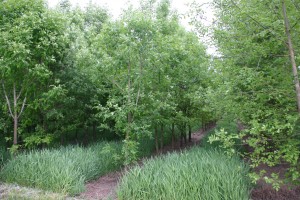
USDA, conservation partners and landowners worked together to protect the Tualatin River Watershed by restoring fish habitat and cooling the stream.
Farmers and ranchers in Oregon have more than the 30th anniversary of USDA’s Conservation Reserve Program (CRP) to celebrate in 2015. The Farm Service Agency (FSA) state staff can also boast about a 10-year partnership that made the Conservation Reserve Enhancement Program (CREP) available to Oregon producers to protect the Tualatin River Watershed.
The local CREP concept all started during a gathering at Ralph Duyck’s farm near Forest Grove in 2005 when a group of conservation enthusiasts came together with the goal of protecting water quality and fish and wildlife habitat.
CREP targets high-priority conservation issues by forming a partnership between the federal government and state or tribal governments or other geopolitical bodies. Once a CREP agreement is formed, landowners can receive annual rental payments in exchange for removing environmentally sensitive land from production and implementing acceptable conservation practices.
Together, USDA, local landowners, Clean Water Services, Tualatin Soil and Water Conservation District and state and local agencies worked to restore fish habitat and cool the stream. Invasive and weedy plants were removed and native vegetation was restored to improve stream habitat health and create shade to keep the water cool. Conservation improvements helped stabilize banks, reduced erosion, slowed and filtered run-off, safeguarded ground and surface water, increased food and shelter for wildlife and pollinators and slowed the spread of invasive weeds.
“The first year we had one project, the next year we had three and by the third year we had 27 projects,” said John McDonald, Chairperson of the Tualatin Soil and Water Conservation District. “The agricultural community bought into the project because of the multiple benefits.”
CREP made it easier for landowners to participate. Their actions protected fish habitat by planting trees that shade and cool streams from the headwaters of the Tualatin to where it enters the Willamette River.
Today, 42 landowners have enrolled a total of 450 acres into CREP. They’re protecting more than 25 miles of stream bank by planting more than 50 different native plant species planted within the buffers.
As part of the program, around 25,000 trees and shrubs have been planted on the Duyck farm since 2005, many of which are Douglas Fir and Western Red Cedar.
“This program is a beautiful working relationship,” said Duyck. “Wildlife is coming into the land because there is vegetation and trees for habitat.”
Lyle Spiesschaert and his family also participate in CREP and have farmed the same land near Forest Grove Council Creek for almost 100 years.
“We have two miles of streams that flow into the Council Creek drainage area and we have planted all native species, trees and shrubs to help cool and filter the water and provide cover for wildlife, pollinators, bees, birds and insects,” said Spiesschaert. “Sometimes you know what is right, but it is hard to do it economically. This program has allowed us to do the right thing for the environment.”
The Tualatin River Watershed partners participated in the “Tree for All” program which set a goal to plant 1 million trees in the area during 2015. USDA CREP projects contributed nearly 220,000 trees and the goal was surpassed by planting more than 1.2 million trees and shrubs in one planting year.
USDA and its partners are hosting a 10th anniversary celebration of the CREP agreement this Saturday that includes a conservation tour and barbeque.
CRP is a voluntary program that allows eligible landowners to receive annual rental payments and cost-share assistance to establish long-term, resource-conserving covers on eligible farmland throughout the duration of their 10 to 15 year contracts.
Since being established on December 23, 1985, CRP has helped prevent more than 8 billion tons of soil from eroding and protected more than 170,000 stream miles with riparian and grass buffers, more than 100,000 acres of bottomland hardwood trees, nearly 300,000 acres of flood-plain wetlands, and 250,000 acres each for duck nesting habitat and upland bird habitat.
2015 marks the 30th Anniversary of CRP. For an interactive tour of CRP success stories from across the U.S., please visit the FSA CRP 30th Anniversary website at http://www.fsa.usda.gov/CRPis30.





